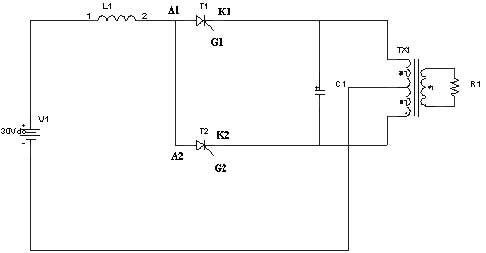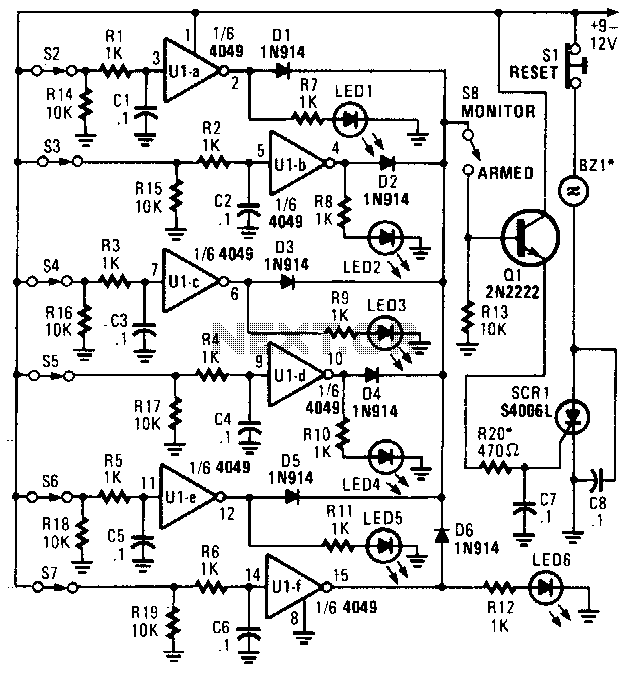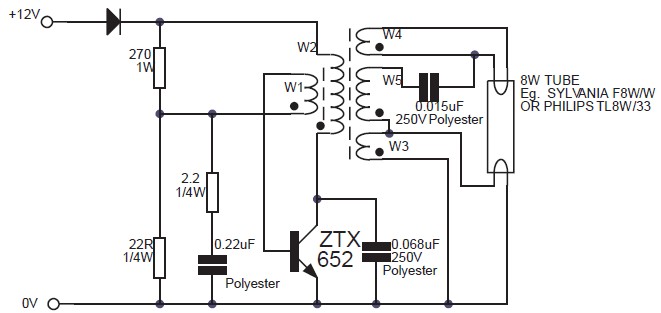
parallel inverter

The inverter plays a crucial role in Uninterrupted Power Supply (UPS) systems. It is responsible for converting direct current (DC) into alternating current (AC) at the required voltage. The fundamental configuration of a single-phase parallel inverter circuit comprises two silicon-controlled rectifiers (SCRs), T1 and T2, an inductor (L), an output transformer, and a commutating capacitor (C). The output voltage and current are denoted as V0 and Io, respectively. The inductor L is designed to maintain a constant source current. During the operation of this inverter, the capacitor C is connected in parallel with the load via the transformer, hence the designation of parallel inverter. The inverter operates in distinct modes. Initially, SCR T1 is conducting, allowing current to flow through the upper half of the primary winding while SCR T2 remains off. Consequently, an electromotive force (emf) Vs is induced across both halves of the primary winding. At time t0, T2 is activated by applying a trigger pulse to its gate. At this moment, the capacitor voltage of 2Vs appears as a reverse bias across T1, resulting in its turn-off. A current Io then flows through T2 and the lower half of the primary winding. The capacitor, now charged from +2Vs to -2Vs by time t=t1, causes the load voltage to transition from Vs at t=0 to Vs at t=t1. Once the capacitor reaches a voltage of Vs, T1 can be triggered at any point. When T1 is activated, the capacitor voltage of 2Vs applies a reverse bias to T2, turning it off. Following the turn-off of T2, the capacitor begins to discharge, reversing its charge direction with the upper plate becoming positive.
The parallel inverter circuit is essential for reliable power conversion in UPS applications. The two SCRs (T1 and T2) serve as controlled switches that manage the flow of current through the transformer, enabling the inverter to produce a stable AC output from a DC input. The inductor (L) plays a pivotal role in maintaining a steady current flow, which is critical for the consistent operation of the inverter. The commutating capacitor (C) facilitates the switching action between the SCRs, allowing for efficient energy transfer and maintaining the desired voltage levels across the load.
In operation, the inverter alternates between the two SCRs to create a square wave output voltage. The timing of the triggering pulses to the gates of T1 and T2 is crucial, as it determines the frequency and waveform of the output voltage. The transformer provides isolation and voltage step-up as required, while the inductor ensures that the current remains stable during the switching transitions. The overall design must account for the ratings of the components, including the voltage and current handling capabilities of the SCRs, the inductance value, and the capacitance of the commutating capacitor, to ensure reliable and efficient operation.
In summary, the parallel inverter circuit is a sophisticated arrangement that effectively converts DC to AC, ensuring uninterrupted power supply to critical loads. Its operation relies on the coordinated switching of SCRs, the stability provided by the inductor, and the timely charging and discharging of the capacitor, all of which contribute to the inverter's performance and reliability in various applications.The inverter plays a vital role in Uninterrupted Power Supply (UPS). It is used to convert the direct current (DC) to alternating Current (AC) of required voltage. The basic single phase parallel inverter circuit consists of two SCRs T1 and T2, an inductor L, an output transformer and a commutating capacitor C. The output voltage and current are V o and Io respectively. The function of L is to make the source current constant. During the working of this inverter, capacitor C comes in parallel with the load via the transformer. So it is called a parallel inverter. The operation of this inverter can be explained in the following modes. In this mode, SCR T1 is conducting and a current flow in the upper half of primary winding. SCR T2 is OFF. As a result an emf Vs is induced across upper as well as lower half of the primary winding. At time to, T2 is turned ON by applying a trigger pulse to its gate. At this time t=0, capacitor voltage 2Vs appears as a reverse bias across T1, it is therefore turned OFF.
A current Io begins to flow through T2 and lower half of primary winding. Now the capacitor has charged (upper plate as negative) from +2Vs to -2Vs at time t=t1. Load voltage also changes from Vs at t=0 to Vs at t=t1. When capacitor has charged to Vs, T1 may be tuned ON at any time. When T1 is triggered, capacitor voltage 2Vs applies a reverse bias across T2, it is therefore turned OFF. After T2 is OFF, capacitor starts discharging, and charged to the opposite direction, the upper plate as positive.
🔗 External reference
The parallel inverter circuit is essential for reliable power conversion in UPS applications. The two SCRs (T1 and T2) serve as controlled switches that manage the flow of current through the transformer, enabling the inverter to produce a stable AC output from a DC input. The inductor (L) plays a pivotal role in maintaining a steady current flow, which is critical for the consistent operation of the inverter. The commutating capacitor (C) facilitates the switching action between the SCRs, allowing for efficient energy transfer and maintaining the desired voltage levels across the load.
In operation, the inverter alternates between the two SCRs to create a square wave output voltage. The timing of the triggering pulses to the gates of T1 and T2 is crucial, as it determines the frequency and waveform of the output voltage. The transformer provides isolation and voltage step-up as required, while the inductor ensures that the current remains stable during the switching transitions. The overall design must account for the ratings of the components, including the voltage and current handling capabilities of the SCRs, the inductance value, and the capacitance of the commutating capacitor, to ensure reliable and efficient operation.
In summary, the parallel inverter circuit is a sophisticated arrangement that effectively converts DC to AC, ensuring uninterrupted power supply to critical loads. Its operation relies on the coordinated switching of SCRs, the stability provided by the inductor, and the timely charging and discharging of the capacitor, all of which contribute to the inverter's performance and reliability in various applications.The inverter plays a vital role in Uninterrupted Power Supply (UPS). It is used to convert the direct current (DC) to alternating Current (AC) of required voltage. The basic single phase parallel inverter circuit consists of two SCRs T1 and T2, an inductor L, an output transformer and a commutating capacitor C. The output voltage and current are V o and Io respectively. The function of L is to make the source current constant. During the working of this inverter, capacitor C comes in parallel with the load via the transformer. So it is called a parallel inverter. The operation of this inverter can be explained in the following modes. In this mode, SCR T1 is conducting and a current flow in the upper half of primary winding. SCR T2 is OFF. As a result an emf Vs is induced across upper as well as lower half of the primary winding. At time to, T2 is turned ON by applying a trigger pulse to its gate. At this time t=0, capacitor voltage 2Vs appears as a reverse bias across T1, it is therefore turned OFF.
A current Io begins to flow through T2 and lower half of primary winding. Now the capacitor has charged (upper plate as negative) from +2Vs to -2Vs at time t=t1. Load voltage also changes from Vs at t=0 to Vs at t=t1. When capacitor has charged to Vs, T1 may be tuned ON at any time. When T1 is triggered, capacitor voltage 2Vs applies a reverse bias across T2, it is therefore turned OFF. After T2 is OFF, capacitor starts discharging, and charged to the opposite direction, the upper plate as positive.
🔗 External reference





